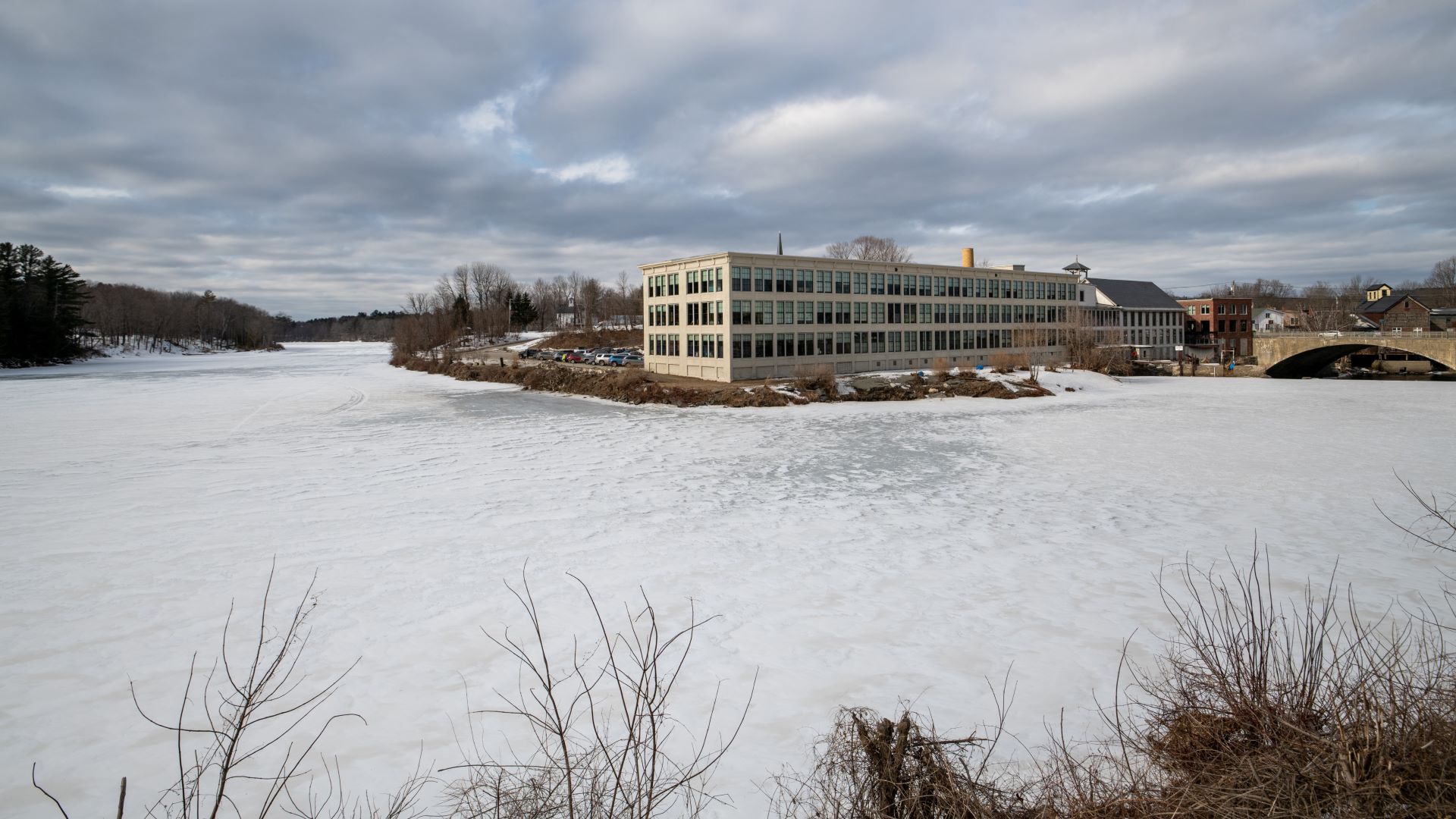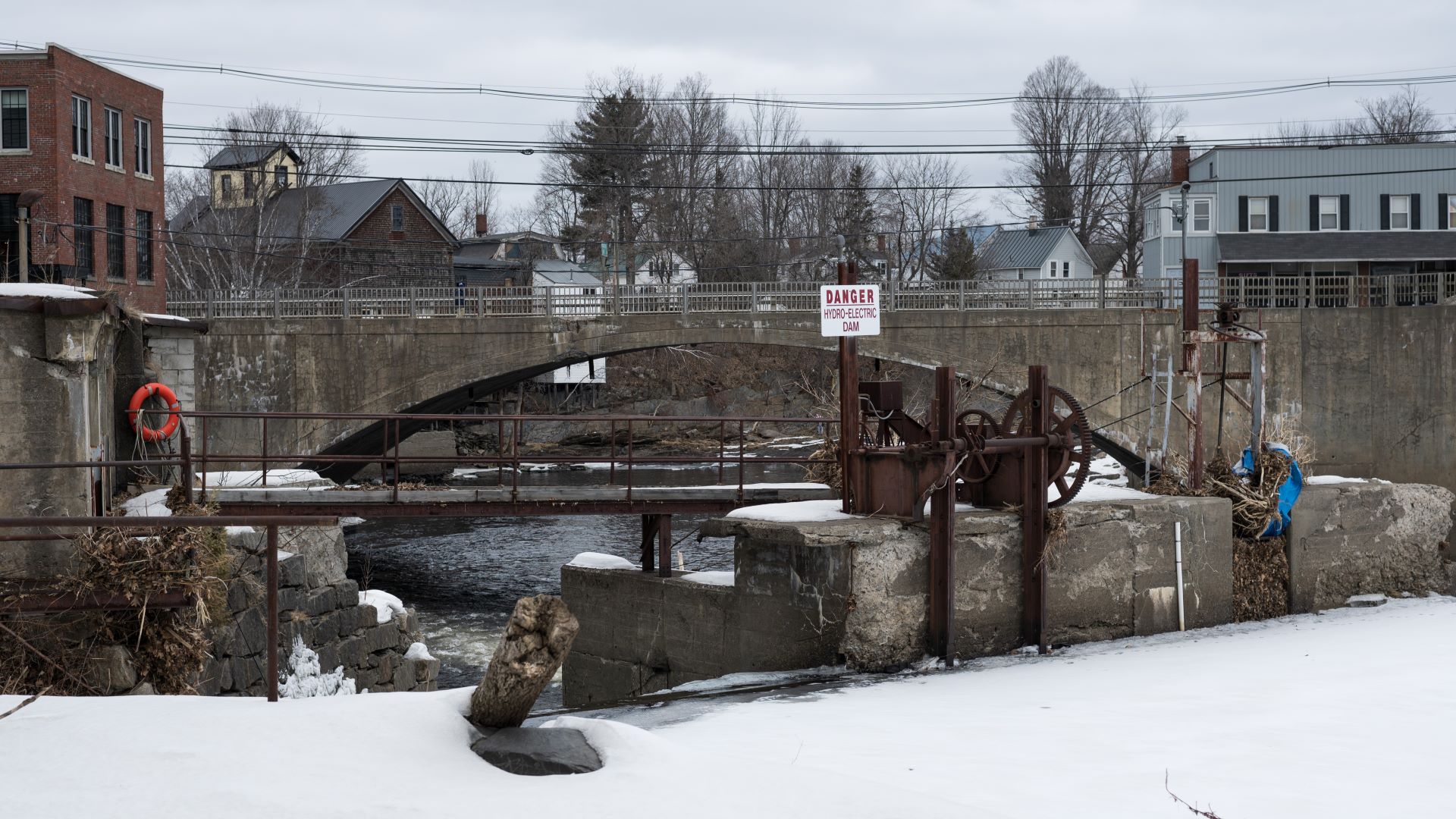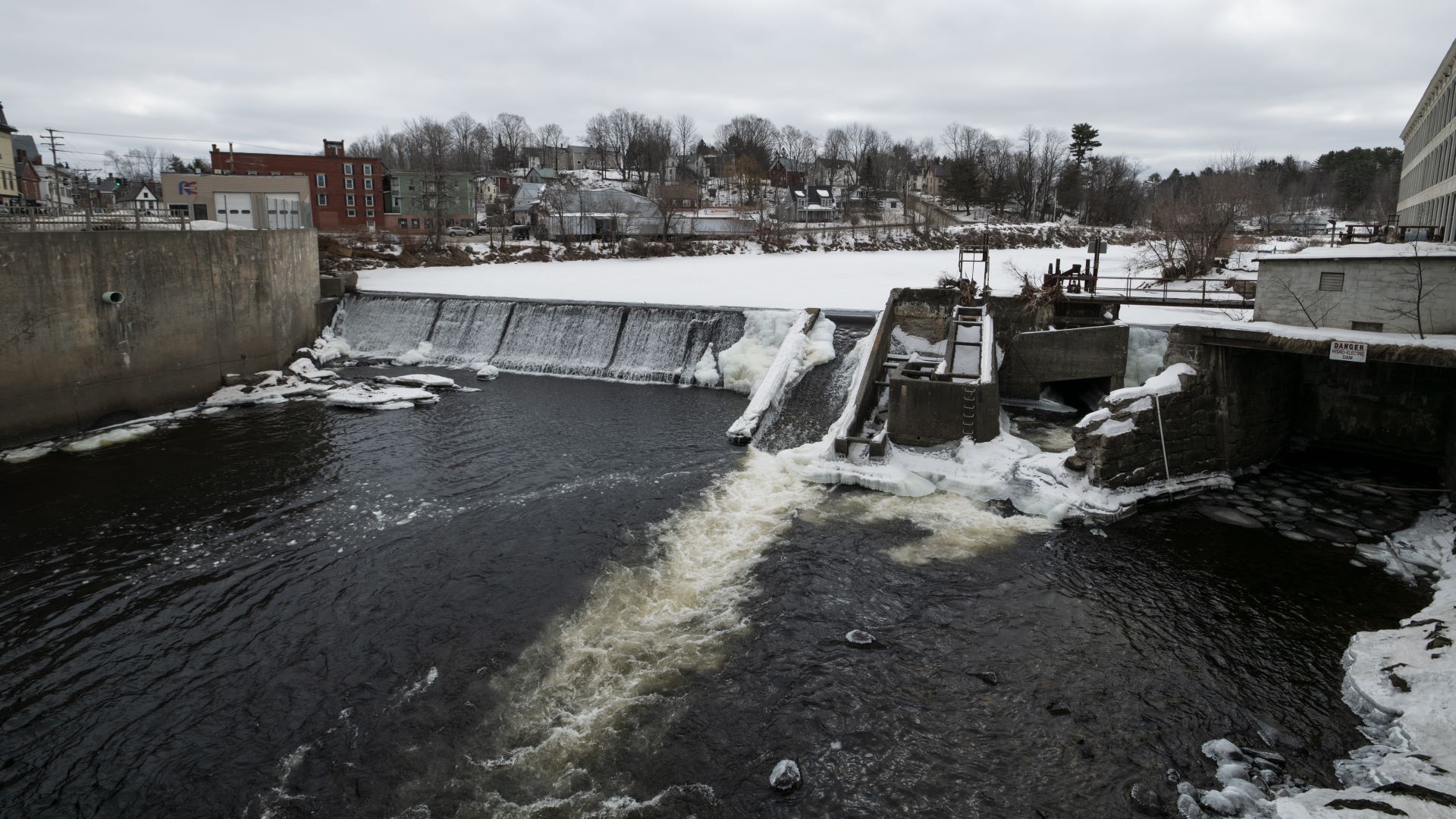The most common argument Dover-Foxcroft select board chair Tom Lizotte hears for keeping the town’s defunct dam on the Piscataquis River is it’s always been there, for as long as residents can remember.
That was the mindset Lizotte himself had when he joined a committee studying what to do with the aging Mayo Mill Dam, which has failed to comply with federal regulations for over a decade.
“I live right up the street from the river and I just couldn’t imagine it looking differently,” Lizotte said in an interview with The Maine Monitor.
Now, more than a year into the committee’s research and a couple of months after a devastating wind and rain storm flooded Dover-Foxcroft from the impoundment behind the dam, Lizotte has changed his mind: The dam must go.
According to a report from town-contracted engineering firms, removing the dam is the best way to reduce Dover-Foxcroft’s susceptibility to flooding, a risk that will only increase with the intensifying precipitation events experts project for Maine in the coming years.
“I think that we’re fooling ourselves if we don’t see more of the impacts from climate change,” Lizotte said, noting that the December storm led to road closures that made it difficult for residents to reach the southern part of the state.
This flood risk is a primary reason Lizotte and a town steering committee — which includes other select board members, and employees of the Atlantic Salmon Federation, Nature Conservancy and the engineering firm Inter-Fluve — are recommending the dam be removed.
The Dover-Foxcroft effort fits into a statewide campaign to remove dams, including downstream of the Mayo Mill Dam on the Penobscot River, where major dams were removed in 2012 and 2013.
“Many people in town have the erroneous impression that the dam actually controls floods, but the exact opposite is true.”
Tom Lizotte, Dover-Foxcroft select board chair
In the past four decades, Maine has removed over 50 dams, according to the nonprofit American Rivers.
Arguments for dam removal in Maine have largely focused on the restoration of habitat for sea-run fisheries like Atlantic salmon. But the December storm highlighted another case for removal: flood resilience in a changing climate.
The firms’ report found the dam substantially increases upstream flood hazards. By holding back water, the dam raises the profile of a 100-year flood by a staggering nine feet.
That influence, compounded by the effects of climate change, puts the town’s infrastructure at risk. South Street, the thoroughfare Lizotte saw flooded in December, is particularly susceptible to flooding from the dam’s impoundment.
“Wow, what a mess that created,” Lizotte said. “Police, fire and public works were all stretched beyond capacity.”
A recent inspection by the Federal Energy Regulatory Commission, which oversees the Mayo Mill dam and other hydroelectric dams, found numerous structural deficiencies. They include significant deterioration of the concrete on the upstream face of the dam as well as a collapsed portion of the powerhouse’s roof.
Just bringing the dam’s structure and powerhouse into compliance with FERC standards would cost around $2 million, according to an estimate by Gomez and Sullivan, one of the engineering firms involved in the study. That doesn’t factor in Endangered Species Act provisions that require more effective passages for Atlantic salmon.
Lizotte said the FERC has been patient as the town weighs its options, but the town needs to act soon.
Since the committee first convened in January 2023, it has held frequent public meetings, including a hearing last month where members explained their recommendation for the dam’s removal. In addition, the committee proposed building a park on the riverbank.
With a projected price tag of around $6 million, removing the dam is cheaper than the alternatives, according to the report. Most of the costs will likely be covered by federal grants.
The steering committee considered 23 options. Alternative propositions that involve restoring the dam, updating a passage for fish and installing flood controls would cost between $7.5 million and $12.4 million, and would bring in fewer opportunities for funding, the committee said.

Still, removing the dam is not popular with everyone.
At last month’s public hearing, many questioned why the town couldn’t repair the dam to the point it could make money by producing electricity.
“I’m disappointed that we haven’t addressed the power generation,” one resident said.
Committee member Maranda Nemeth, a project manager for the Atlantic Salmon Federation, said the town would be unlikely to secure funding for a proposal that didn’t address the flood risk.
“I am not aware of any funder that would be interested in repairing a dam that perpetuates future flooding and the risk that comes with that,” Nemeth said.
Other residents raised concerns about boating, property values, aesthetics and the dam’s cultural significance.
The dam’s powerhouse is nestled into the western bank of the Piscataquis River, right in Dover-Foxcroft’s downtown. Behind it, after an elbow-shaped bend in the river, the water pools into an impoundment popular for canoeing and the occasional seaplane landing.
Projections show removing the dam would make this portion narrower and lead to swifter currents. The report said it would still be a good setting for recreational boating but could require changes to seaplane landing protocol.
Janet Colbry, a Dover-Foxcroft resident and business owner, has lived along the Piscataquis River for 64 years. She said she can’t imagine what it would look like without the dam, or with a lower depth. Her father moved to town in the 1940s, and her children grew up canoeing and kayaking upstream of the dam. She’s attached to the river in its current form.
What concerns Colbry most is the effect the dam’s removal could have on local businesses. She said the way the Piscataquis cascades over the historic structure captures the eyes of passing motorists, who stop to take pictures and linger in town.
“The river itself is just beautiful,” Colbry said, noting that tourists “park along the main street, get out, walk over and watch the water come down over this dam.”
Colbry said she recognizes the dam contributes to the town’s flood risk, but she favors an alternative presented in the report that leaves the dam in place and adds a fish passage as well as gates that could be used to reduce flooding.

As it stands, the dam has no flood control capabilities, according to the engineering firms’ report. The study noted that reducing the size of the flood zone would mean that fewer building owners would need to purchase flood insurance.
A resident of the apartment complex located in an old mill building next to the dam, which was hit hard by the December storm, praised the potential effects of dam removal. He said his building’s basement and parking lot filled with several feet of water, and the elevator was damaged.
“Many people in town have the erroneous impression that the dam actually controls floods, but the exact opposite is true,” Lizotte said.
Still, Lizotte acknowledged it’s “an emotional decision,” and would represent a major change for the community.
First built in the 1800s, the Mayo Mill Dam was reconstructed with concrete in 1920, then further refurbished in 1982 by the Moosehead Manufacturing Company. Moosehead closed in 2007, after which the dam’s powerhouse became inoperable. The town assumed ownership in 2010.
A 2014 proposal to redevelop the dam to produce power did not pan out, and when the town requested proposals for redeveloping the site in 2022, the Atlantic Salmon Federation, Nature Conservancy and Inter-Fluve were the only ones to bite.
The Dover-Foxcroft select board is expected to vote on the removal next month, with a full town vote this summer.
In the meantime, Lizotte said he has worked to inform the public about the potential risks posed by the dam.
He said it would be easier to turn a blind eye to climate change, which some community members aren’t fully convinced exists, but “to not do something about it would be governmental malpractice.”
Dover-Foxcroft’s vote comes more than a year after Farmington removed the Walton’s Mill Dam on Temple Stream, a tributary to the Sandy River.
Committee members said Farmington residents were worried about how the area would look after the dam was removed, but remarked that people are enjoying the new park.
The Atlantic Salmon Federation has been involved in both Farmington’s dam removal and Dover-Foxcroft’s study. John Burrows, vice president of the organization’s U.S. operations, said he hopes the Dover-Foxcroft outcome will be similar to what happened in Farmington, where they documented the respawning of Atlantic salmon upstream of the former dam.
Burrows said rivers are best equipped to shelter breeding aquatic life from rising summer temperatures when they’re free-flowing because that helps them stay cool. A stagnant stretch of river, which occurs in the impoundments behind dams, is more likely to stay warmer longer and result in lower dissolved oxygen levels.
“Well-forested habitat that’s cold: That’s a place where we would see a lot of natural reproduction,” Burrows said. “It would be a big step toward getting us on the path to recovery.”

Along with the Atlantic Salmon Federation and other environmental nonprofits, the Penobscot Nation has been involved in broader removal efforts across the Penobscot River watershed, where it has helped purchase dams so they can be dismantled or restructured to allow for natural fish passages.
After the removal of the Veazie and Great Works dams in the early 2010s, Penobscot Nation members lauded the cultural significance of an unimpeded Penobscot River. Since then the tribe has hosted national whitewater canoe races and welcomed the return of sea-run fish.
Dan McCaw, fisheries manager for the Penobscot Nation, said in an interview with the Monitor that he’s been closely following the deliberations in Dover-Foxcroft because of the importance of the Piscataquis River to the Penobscot River watershed.
“The Penobscot River itself is a tribal member,” McCaw said. “So there’s a very different relationship that the tribe has with the river than most non-tribal members.”
He noted the Piscataquis River’s proximity to the Atlantic Ocean makes it a particularly valuable salmon breeding ground.
“We see that the Piscataquis is one of the places in the Penobscot River ecosystem that has an abundance of high quality salmon habitat, and getting adults into that system to spawn is extremely important,” McCaw said.
Whether Dover-Foxcroft chooses to install more robust fishways or remove the dam altogether, McCaw said the tribe will support the decision. He commended the town’s plans to put the dam’s future to a vote and the committee’s frequent public meetings to explain the technical studies.
“The tribe is very respectful of the fact that their grandparents and great grandparents have driven by that place and maybe took their canoe out in the impoundment,” McCaw said. “So it is a balancing act between respecting local communities, but also hoping that communities will think about the bigger picture.”







